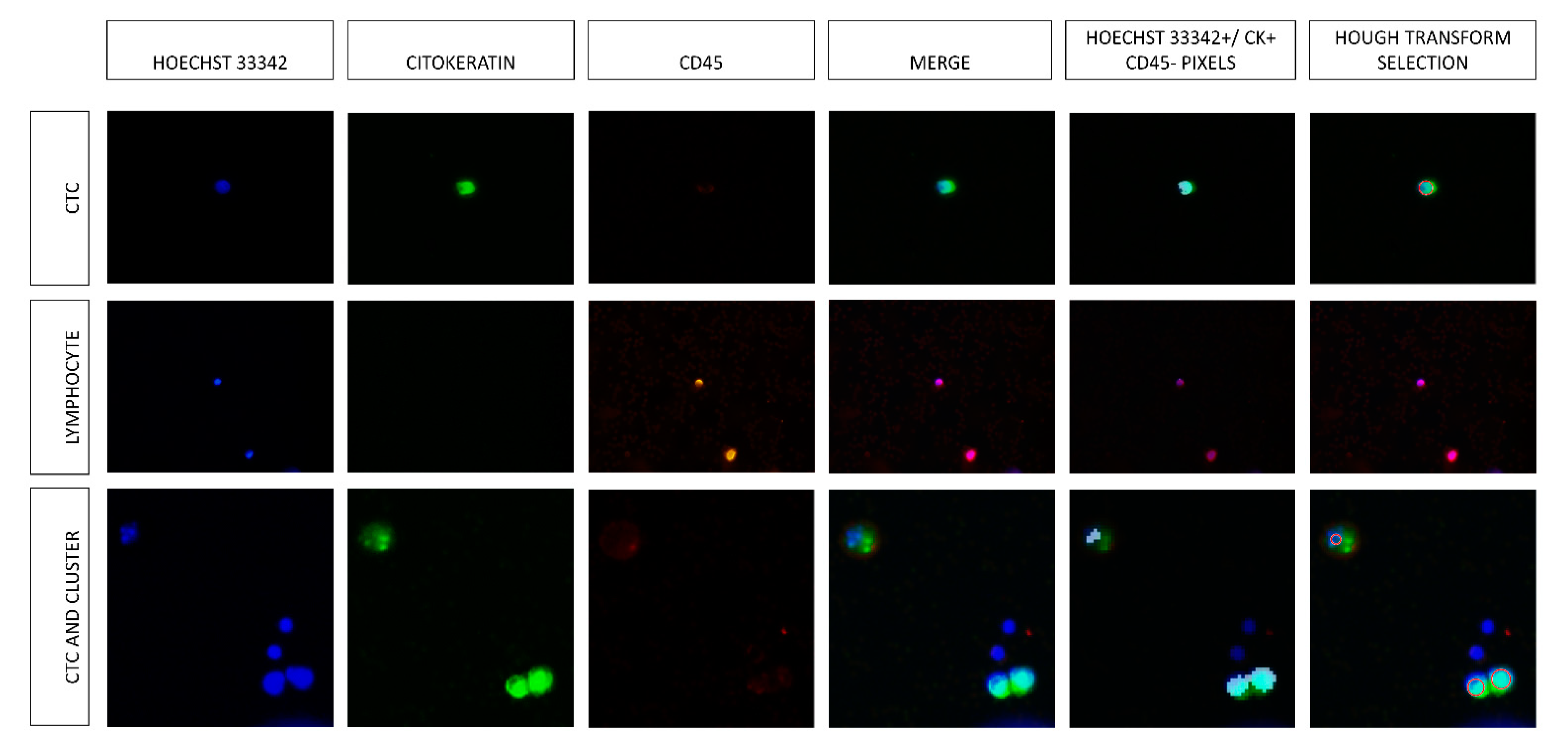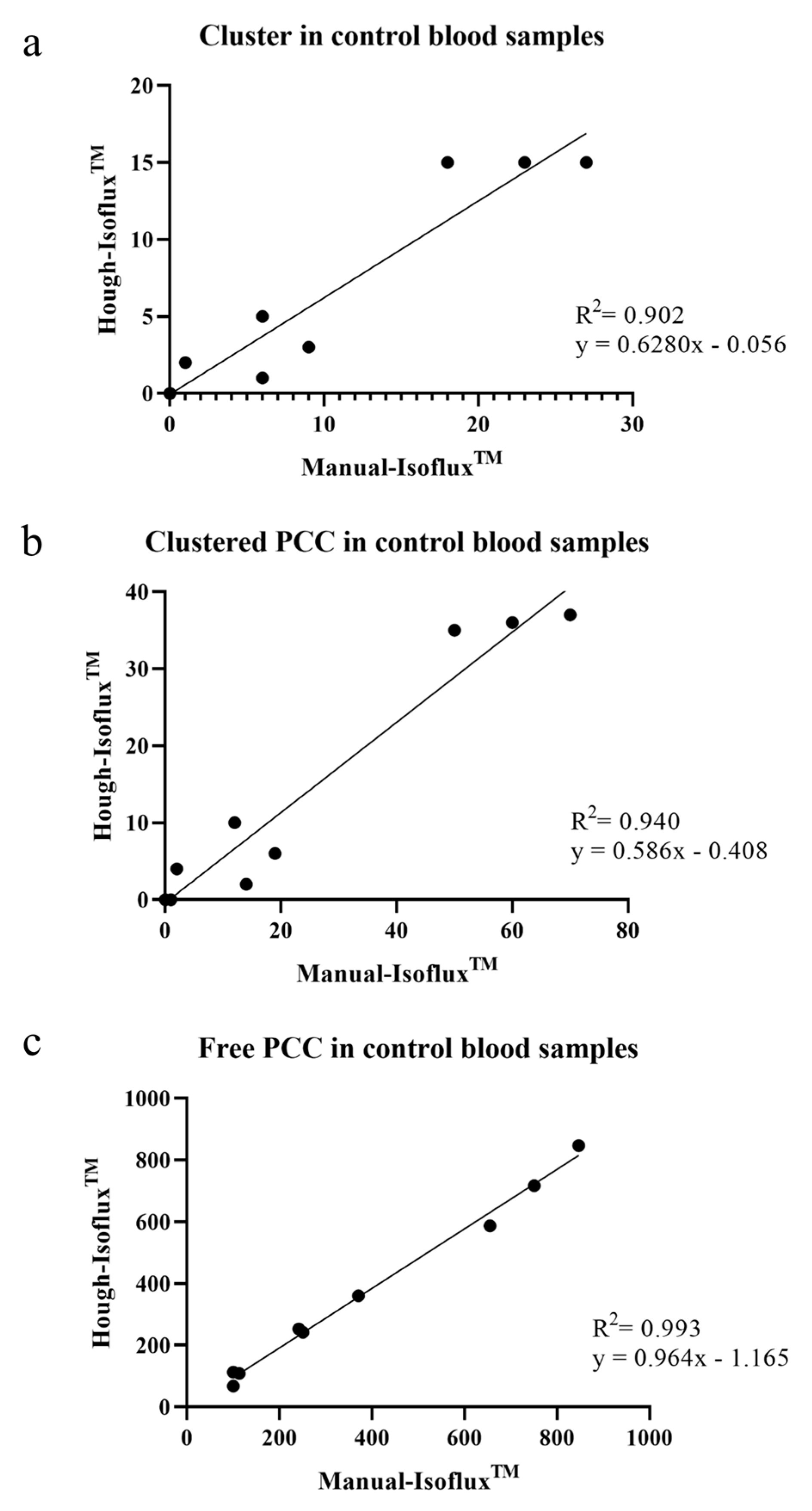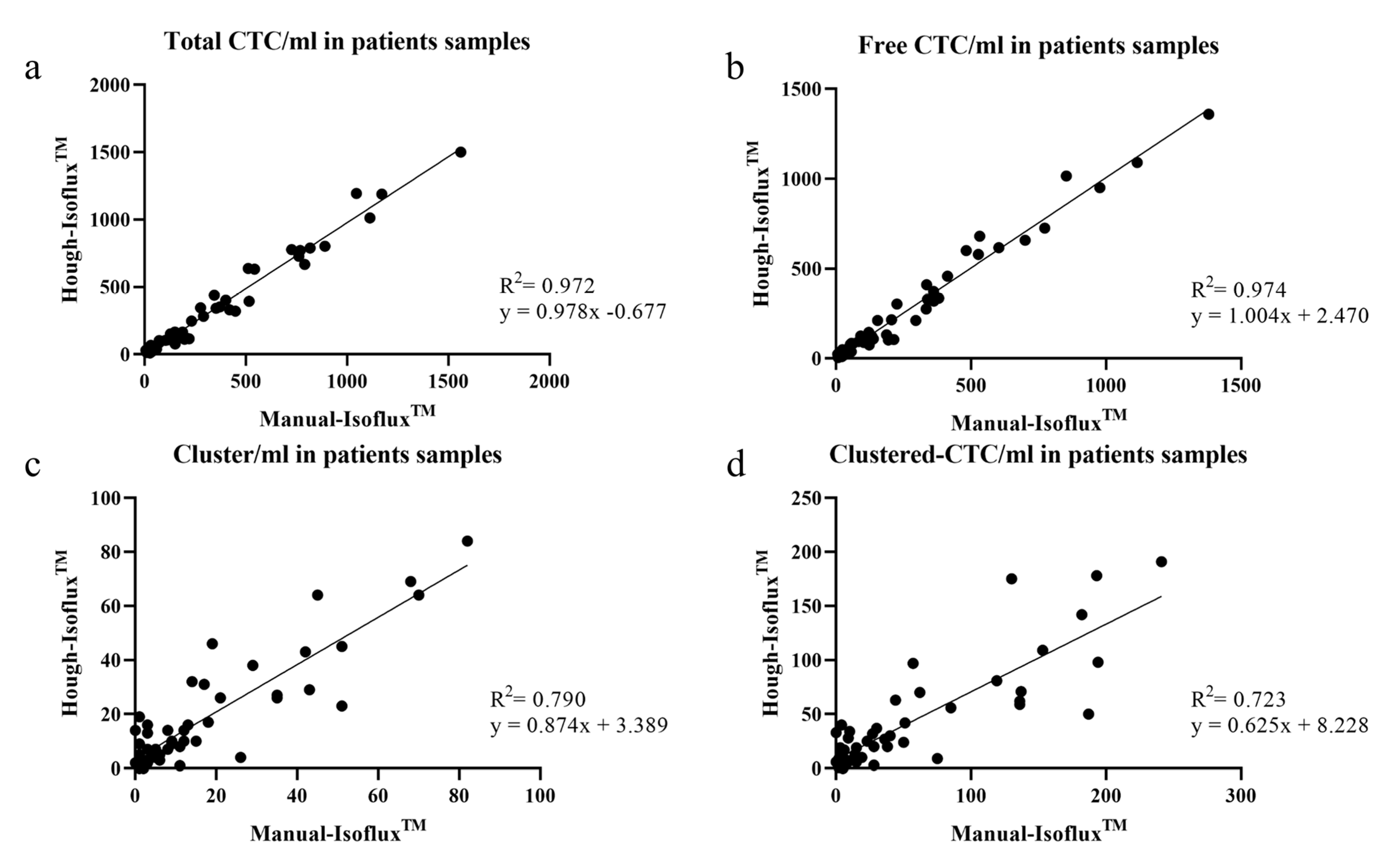Quantification and Characterization of CTCs and Clusters in Pancreatic Cancer by Means of the Hough Transform Algorithm
Abstract
:1. Introduction
2. Results
2.1. Experimental Validation
2.1.1. Isolated Pancreatic Cancer Cell (PCC) Evaluation
2.1.2. Cluster Evaluation
2.2. Clinical Validation
CTCs and Cluster Measurements in Patients with PDAC
2.3. CTC Size and Cluster Size
3. Discussion
4. Materials and Methods
4.1. Collection of the Samples
4.2. Cell Culture
4.3. Sample Preparation for Recovery, Accuracy, Sensitivity, and Linearity of PCC Detection
4.4. Reproducibility of CTC Measurements between Duplicate Samples and Multiple Operators
4.5. Isolation of Circulating Tumor Cells
4.6. Software Counting Development
4.6.1. Image Pre-Processing
4.6.2. Image Segmentation
4.6.3. Image Post-Processing
4.7. Statistics
5. Conclusions
6. Patents
Author Contributions
Funding
Institutional Review Board Statement
Informed Consent Statement
Data Availability Statement
Acknowledgments
Conflicts of Interest
References
- Sung, H.; Ferlay, J.; Siegel, R.L.; Laversanne, M.; Soerjomataram, I.; Jemal, A.; Bray, F. Global Cancer Statistics 2020: GLOBOCAN Estimates of Incidence and Mortality Worldwide for 36 Cancers in 185 Countries. CA Cancer J. Clin. 2021, 71, 209–249. [Google Scholar] [CrossRef] [PubMed]
- Pantel, K.; Alix-Panabières, C. Liquid biopsy and minimal residual disease—Latest advances and implications for cure. Nat. Rev. Clin. Oncol. 2019, 16, 409–424. [Google Scholar] [CrossRef] [PubMed]
- Connors, D.; Allen, J.; Alvarez, J.D.; Boyle, J.; Cristofanilli, M.; Hiller, C.; Keating, S.; Kelloff, G.; Leiman, L.; McCormack, R.; et al. International liquid biopsy standardization alliance white paper. Crit. Rev. Oncol. Hematol. 2020, 156, 103112. [Google Scholar] [CrossRef]
- Rolfo, C.; Cardona, A.F.; Cristofanilli, M.; Paz-Ares, L.; Diaz Mochon, J.J.; Duran, I.; Raez, L.E.; Russo, A.; Lorente, J.A.; Malapelle, U.; et al. Challenges and opportunities of cfDNA analysis implementation in clinical practice: Perspective of the International Society of Liquid Biopsy (ISLB). Crit. Rev. Oncol. Hematol. 2020, 151, 102978. [Google Scholar] [CrossRef]
- Malapelle, U.; Pisapia, P.; Addeo, A.; Arrieta, O.; Bellosillo, B.; Cardona, A.F.; Cristofanilli, M.; De Miguel-Perez, D.; Denninghoff, V.; Durán, I.; et al. Liquid biopsy from research to clinical practice: Focus on non-small cell lung cancer. Expert Rev. Mol. Diagn. 2021, 21, 1165–1178. [Google Scholar] [CrossRef]
- Anfossi, S.; Babayan, A.; Pantel, K.; Calin, G.A. Clinical utility of circulating non-coding RNAs—An update. Nat. Rev. Clin. Oncol. 2018, 15, 541–563. [Google Scholar] [CrossRef]
- Lai, C.-H.; Chang, Y.-C. Microfluidic Capture and Multiplex Immunofluorescence of Circulating Tumor Cells to Identify Cancer of Origin. In Circulating Tumor Cells; Methods in Molecular Biology; Springer: Berlin, Germany, 2017; Volume 1634, pp. 1–19. [Google Scholar]
- Yap, T.A.; Lorente, D.; Omlin, A.; Olmos, D.; de Bono, J.S. Circulating tumor cells: A multifunctional biomarker. Clin. Cancer Res. Off. J. Am. Assoc. Cancer Res. 2014, 20, 2553–2568. [Google Scholar] [CrossRef] [Green Version]
- Paoletti, C.; Hayes, D.F. Circulating Tumor Cells. In Novel Biomarkers in the Continuum of Breast Cancer; Stearns, V., Ed.; Springer International Publishing: Cham, Switzerland, 2016; pp. 235–258. [Google Scholar] [CrossRef]
- Allard, W.J.; Matera, J.; Miller, M.C.; Repollet, M.; Connelly, M.C.; Rao, C.; Tibbe, A.G.; Uhr, J.W.; Terstappen, L.W. Tumor cells circulate in the peripheral blood of all major carcinomas but not in healthy subjects or patients with nonmalignant diseases. Clin. Cancer Res. Off. J. Am. Assoc. Cancer Res. 2004, 10, 6897–6904. [Google Scholar] [CrossRef] [Green Version]
- Andree, K.C.; van Dalum, G.; Terstappen, L.W.M.M. Challenges in circulating tumor cell detection by the CellSearch system. Mol. Oncol. 2016, 10, 395–407. [Google Scholar] [CrossRef] [Green Version]
- Dakubo, G.D. Cancer Biomarkers in Body Fluids: Principles; Springer: Berlin, Germany, 2016; pp. 1–299. [Google Scholar]
- Kaldjian, E.P.; Ramirez, A.B.; Sun, Y.; Campton, D.E.; Werbin, J.L.; Varshavskaya, P.; Quarre, S.; George, T.; Madan, A.; Blau, C.A.; et al. The RareCyte® platform for next-generation analysis of circulating tumor cells. Cytom. Part A 2018, 93, 1220–1225. [Google Scholar] [CrossRef] [PubMed] [Green Version]
- Ruiz-Rodríguez, A.J.; Molina-Vallejo, M.P.; Aznar-Peralta, I.; González Puga, C.; Cañas García, I.; González, E.; Lorente, J.A.; Serrano, M.J.; Garrido-Navas, M.C. Deep Phenotypic Characterisation of CTCs by Combination of Microfluidic Isolation (IsoFlux) and Imaging Flow Cytometry (ImageStream). Cancers 2021, 13, 6386. [Google Scholar] [CrossRef] [PubMed]
- Mohamed Suhaimi, N.-A.; Foong, Y.M.; Lee, D.Y.S.; Phyo, W.M.; Cima, I.; Lee, E.X.W.; Goh, W.L.; Lim, W.Y.; Chia, K.S.; Kong, S.L.; et al. Non-invasive sensitive detection of KRAS and BRAF mutation in circulating tumor cells of colorectal cancer patients. Mol. Oncol. 2015, 9, 850–860. [Google Scholar] [CrossRef] [PubMed] [Green Version]
- Alva, A.; Friedlander, T.; Clark, M.; Huebner, T.; Daignault, S.; Hussain, M.; Lee, C.; Hafez, K.; Hollenbeck, B.; Weizer, A.; et al. Circulating Tumor Cells as Potential Biomarkers in Bladder Cancer. J. Urol. 2015, 194, 790–798. [Google Scholar] [CrossRef]
- Ma, Y.; Luk, A.; Young, F.P.; Lynch, D.; Chua, W.; Balakrishnar, B.; De Souza, P.; Becker, T.M. Droplet Digital PCR Based Androgen Receptor Variant 7 (AR-V7) Detection from Prostate Cancer Patient Blood Biopsies. Int. J. Mol. Sci. 2016, 17, 1264. [Google Scholar] [CrossRef] [PubMed] [Green Version]
- Rao, Q.; Zhang, Q.; Zheng, C.; Dai, W.; Zhang, B.; Ionescu-Zanetti, C.; Lin, Z.; Zhang, L. Detection of circulating tumour cells in patients with epithelial ovarian cancer by a microfluidic system. Int. J. Clin. Exp. Pathol. 2017, 10, 9599–9606. [Google Scholar]
- Sánchez-Lorencio, M.I.; Ramirez, P.; Saenz, L.; Martínez Sánchez, M.V.; De La Orden, V.; Mediero-Valeros, B.; Veganzones-De-Castro, S.; Baroja-Mazo, A.; Nuin, B.R.; Gonzalez, M.R.; et al. Comparison of Two Types of Liquid Biopsies in Patients with Hepatocellular Carcinoma Awaiting Orthotopic Liver Transplantation. Transplant. Proc. 2015, 47, 2639–2642. [Google Scholar] [CrossRef]
- Ramirez, P.; Sáenz, L.; Cascales-Campos, P.A.; González Sánchez, M.R.; Llàcer-Millán, E.; Sánchez-Lorencio, M.I.; Díaz-Rubio, E.; De La Orden, V.; Mediero-Valeros, B.; Navarro, J.L.; et al. Oncological Evaluation by Positron-emission Tomography, Circulating Tumor Cells and Alpha Fetoprotein in Patients with Hepatocellular Carcinoma on the Waiting List for Liver Transplantation. Transplant. Proc. 2016, 48, 2962–2965. [Google Scholar] [CrossRef]
- Vilhav, C.; Engström, C.; Naredi, P.; Novotny, A.; Bourghardt-Fagman, J.; Iresjö, B.-M.; Asting, A.G.; Lundholm, K. Fractional uptake of circulating tumor cells into liver-lung compartments during curative resection of periampullary cancer. Oncol. Lett. 2018, 16, 6331–6338. [Google Scholar] [CrossRef] [Green Version]
- Amado, V.; González-Rubio, S.; Zamora, J.; Alejandre, R.; Espejo-Cruz, M.L.; Linares, C.; Sánchez-Frías, M.; García-Jurado, G.; Montero, J.L.; Ciria, R.; et al. Clearance of Circulating Tumor Cells in Patients with Hepatocellular Carcinoma Undergoing Surgical Resection or Liver Transplantation. Cancers 2021, 13, 2476. [Google Scholar] [CrossRef]
- Wu, J.; Raba, K.; Guglielmi, R.; Behrens, B.; Van Dalum, G.; Flügen, G.; Koch, A.; Patel, S.; Knoefel, W.T.; Stoecklein, N.H.; et al. Magnetic-Based Enrichment of Rare Cells from High Concentrated Blood Samples. Cancers 2020, 12, 933. [Google Scholar] [CrossRef] [Green Version]
- Alvarez Cubero, M.J.; Lorente, J.A.; Robles-Fernandez, I.; Rodriguez-Martinez, A.; Puche, J.L.; Serrano, M.J. Circulating Tumor Cells: Markers and Methodologies for Enrichment and Detection. In Circulating Tumor Cells; Methods in Molecular Biology; Springer: Berlin, Germany, 2017; Volume 1634, pp. 283–303. [Google Scholar]
- Hou, J.-M.; Krebs, M.G.; Lancashire, L.; Sloane, R.; Backen, A.; Swain, R.K.; Priest, L.J.; Greystoke, A.; Zhou, C.; Morris, K.; et al. Clinical significance and molecular characteristics of circulating tumor cells and circulating tumor microemboli in patients with small-cell lung cancer. J. Clin. Oncol. Off. J. Am. Soc. Clin. Oncol. 2012, 30, 525–532. [Google Scholar] [CrossRef] [PubMed]
- Aceto, N.; Bardia, A.; Miyamoto, D.T.; Donaldson, M.C.; Wittner, B.S.; Spencer, J.A.; Yu, M.; Pely, A.; Engstrom, A.; Zhu, H.; et al. Circulating tumor cell clusters are oligoclonal precursors of breast cancer metastasis. Cell 2014, 158, 1110–1122. [Google Scholar] [CrossRef] [PubMed] [Green Version]
- Fabisiewicz, A.; Grzybowska, E. CTC clusters in cancer progression and metastasis. Med. Oncol. 2017, 34, 12. [Google Scholar] [CrossRef] [PubMed]
- Venkatalakshmi, B.; Thilagavathi, K. Automatic red blood cell counting using hough transform. In Proceedings of the 2013 IEEE Conference on Information Communication Technologies, Thuckalay, India, 11–12 April 2013; pp. 267–271. [Google Scholar]
- Bewes, J.M.; Suchowerska, N.; McKenzie, D.R. Automated cell colony counting and analysis using the circular Hough image transform algorithm (CHiTA). Phys. Med. Biol. 2008, 53, 5991–6008. [Google Scholar] [CrossRef] [PubMed]
- Bukowska, D.M.; Chew, A.L.; Huynh, E.; Kashani, I.; Wan, S.L.; Wan, P.M.; Chen, F.K. Semi-automated identification of cones in the human retina using circle Hough transform. Biomed. Opt. Express 2015, 6, 4676. [Google Scholar] [CrossRef] [Green Version]
- Acharya, V.; Kumar, P. Identification and red blood cell automated counting from blood smear images using computer-aided system. Med. Biol. Eng. Comput. 2018, 56, 483–489. [Google Scholar] [CrossRef]
- Zhang, L.; Ye, Y.; Dhar, R.; Deng, J.; Tang, H. Estimating Dynamic Cellular Morphological Properties via the Combination of the RTCA System and a Hough-Transform-Based Algorithm. Cells 2019, 8, 1287. [Google Scholar] [CrossRef] [Green Version]
- Matas, J.; Galambos, C.; Kittler, J. Robust Detection of Lines Using the Progressive Probabilistic Hough Transform. Comput. Vis. Image Underst. 2000, 78, 119–137. [Google Scholar] [CrossRef]
- Xu, Z.; Shin, B.-S.; Klette, R. Closed form line-segment extraction using the Hough transform. Pattern Recognit. 2015, 48, 4012–4023. [Google Scholar] [CrossRef]
- Smith, R.; Najarian, K.; Ward, K. A hierarchical method based on active shape models and directed Hough transform for segmentation of noisy biomedical images; application in segmentation of pelvic X-ray images. BMC Med. Inform. Decis. Mak. 2009, 9, S2. [Google Scholar] [CrossRef] [Green Version]
- Parkinson, D.R.; Dracopoli, N.; Petty, B.G.; Compton, C.; Cristofanilli, M.; Deisseroth, A.; Hayes, D.F.; Kapke, G.; Kumar, P.; Lee, J.S.; et al. Considerations in the development of circulating tumor cell technology for clinical use. J. Transl. Med. 2012, 10, 138. [Google Scholar] [CrossRef] [PubMed] [Green Version]
- Hendricks, A.; Dall, K.; Brandt, B.; Geisen, R.; Röder, C.; Schafmayer, C.; Becker, T.; Hinz, S.; Sebens, S. Longitudinal Analysis of Circulating Tumor Cells in Colorectal Cancer Patients by a Cytological and Molecular Approach: Feasibility and Clinical Application. Front. Oncol. 2021, 11, 646885. [Google Scholar] [CrossRef] [PubMed]
- Vasseur, A.; Kiavue, N.; Bidard, F.-C.; Pierga, J.-Y.; Cabel, L. Clinical utility of circulating tumor cells: An update. Mol. Oncol. 2021, 15, 1647–1666. [Google Scholar] [CrossRef]
- Riethdorf, S.; O’Flaherty, L.; Hille, C.; Pantel, K. Clinical applications of the CellSearch platform in cancer patients. Adv. Drug Deliv. Rev. 2018, 125, 102–121. [Google Scholar] [CrossRef]
- Cristofanilli, M. Circulating Tumor Cells, Disease Progression, and Survival in Metastatic Breast Cancer. Semin. Oncol. 2006, 33 (Suppl. 9), 9–14. [Google Scholar] [CrossRef]
- Nelep, C.; Eberhardt, J. Automated rare single cell picking with the ALS cellcelectorTM. Cytom. Part A 2018, 93, 1267–1270. [Google Scholar] [CrossRef] [Green Version]
- Di Trapani, M.; Manaresi, N.; Medoro, G. DEPArrayTM system: An automatic image-based sorter for isolation of pure circulating tumor cells. Cytom. Part A 2018, 93, 1260–1266. [Google Scholar] [CrossRef] [Green Version]
- Scholtens, T.M.; Schreuder, F.; Ligthart, S.T.; Swennenhuis, J.F.; Tibbe, A.G.J.; Greve, J.; Terstappen, L.W. CellTracks TDI: An image cytometer for cell characterization. Cytom. Part A 2011, 79, 203–213. [Google Scholar] [CrossRef]
- Agerbæk, M.Ø.; Bang-Christensen, S.R.; Yang, M.-H.; Clausen, T.M.; Pereira, M.A.; Sharma, S.; Ditlev, S.B.; Nielsen, M.A.; Choudhary, S.; Gustavsson, T.; et al. The VAR2CSA malaria protein efficiently retrieves circulating tumor cells in an EpCAM-independent manner. Nat. Commun. 2018, 9, 3279. [Google Scholar] [CrossRef] [Green Version]
- Padillo-Ruiz, J.; Suarez, G.; Pereira, S.; Calero-Castro, F.J.; Tinoco, J.; Marin, L.; Bernal, C.; Cepeda-Franco, C.; Alamo, J.M.; Almoguera, F.; et al. Circulating Tumor Cells Enumeration from the Portal Vein for Risk Stratification in Early Pancreatic Cancer Patients. Cancers 2021, 13, 6153. [Google Scholar] [CrossRef]
- Cao, J.; Chen, L.; Wang, M.; Tian, Y. Implementing a Parallel Image Edge Detection Algorithm Based on the Otsu-Canny Operator on the Hadoop Platform. Comput. Intell. Neurosci. 2018, 2018, 3598284. [Google Scholar] [CrossRef] [PubMed] [Green Version]
- Al-Kofahi, Y.; Lassoued, W.; Lee, W.; Roysam, B. Improved automatic detection and segmentation of cell nuclei in histopathology images. IEEE Trans. Biomed. Eng. 2010, 57, 841–852. [Google Scholar] [CrossRef] [PubMed]
- Nnolim, U.A. Automated crack segmentation via saturation channel thresholding, area classification and fusion of modified level set segmentation with Canny edge detection. Heliyon 2020, 6, e05748. [Google Scholar] [CrossRef] [PubMed]
- Barriere, G.; Fici, P.; Gallerani, G.; Fabbri, F.; Zoli, W.; Rigaud, M. Circulating tumor cells and epithelial, mesenchymal and stemness markers: Characterization of cell subpopulations. Ann. Transl. Med. 2014, 2, 109. [Google Scholar]
- Chen, J.; Wang, H.; Zhou, L.; Liu, Z.; Tan, X. A combination of circulating tumor cells and CA199 improves the diagnosis of pancreatic cancer. J. Clin. Lab. Anal. 2022, 36, e24341. [Google Scholar] [CrossRef]




| Control Density PCC | Counted Cells (n) | Recovery from Control (%) | ||||
|---|---|---|---|---|---|---|
| Manual-IsofluxTM | Hough Transform-IsofluxTM | p-Value | Manual-IsofluxTM | Hough Transform -IsofluxTM | p-Value | |
| No added PCC | 3.67 ± 2.60 | 6.40 ± 4.34 | 0.263 | - | - | - |
| 100 | 105.33 ± 8.39 | 98.00 ± 25.98 | 1.000 | 89.92 ± 10.98 | 88.43 ± 22.75 | 0.924 |
| 300 | 302.67 ± 69.97 | 291.00 ± 68.51 | 0.847 | 84.04 ± 2.83 | 86.17 ± 11.45 | 0.782 |
| 1000 | 811.00 ± 86.00 | 753.00 ± 129.00 | 0.552 | 73.16 ± 3.50 | 67.66 ± 6.29 | 0.256 |
| Control Density PCC | Clusters (n) | Clustered-PCCs (n) | Free-PCCs (n) | ||||||
|---|---|---|---|---|---|---|---|---|---|
| Manual-IsofluxTM | Hough Transform-IsofluxTM | p Value | Manual-Isoflux TM | Hough Transform-IsofluxTM | p Value | Manual-IsofluxTM | Hough Transform-IsofluxTM | p Value | |
| No added PCC | 0 | 0 | - | 0 | 0 | - | 3.67 ± 2.60 | 6.40 ± 4.34 | 0.263 |
| 100 | 0.33 ± 0.58 | 0.67 ± 1.15 | 1.000 | 0.67 ± 1.15 | 1.33 ± 2.31 | 1.000 | 104.67 ± 7.23 | 96.67 ± 24.91 | 0.621 |
| 300 | 7.00 ± 1.73 | 3.00 ± 2.00 | 0.100 | 15.00 ± 3.61 | 6.00 ± 4.00 | 0.044 | 287.67 ± 72.34 | 285.00 ± 65.18 | 0.964 |
| 1000 | 22.67 ± 4.51 | 15.00 ± 00 | 0.042 | 60.00 ± 10.00 | 36.00 ± 1.00 | 0.014 | 751.00 ± 96.00 | 717.00 ± 130.00 | 0.736 |
| Group | Manual-IsofluxTM | Hough-IsofluxTM | p-Value |
|---|---|---|---|
| Total-CTCs/mL | 192.00 (70, 513) | 152 (83.25, 487.50) | 0.912 |
| Cluster/mL | 8.50 (2, 22.50) | 10 (3.75, 26.25) | 0.437 |
| Clustered-CTCs/mL | 25 (5.75, 77.50) | 24.50 (8.75, 59.75) | 0.942 |
| Free-CTCs/mL | 146.00 (54.50, 388.25) | 124.5 (72.50, 422) | 0.994 |
Disclaimer/Publisher’s Note: The statements, opinions and data contained in all publications are solely those of the individual author(s) and contributor(s) and not of MDPI and/or the editor(s). MDPI and/or the editor(s) disclaim responsibility for any injury to people or property resulting from any ideas, methods, instructions or products referred to in the content. |
© 2023 by the authors. Licensee MDPI, Basel, Switzerland. This article is an open access article distributed under the terms and conditions of the Creative Commons Attribution (CC BY) license (https://creativecommons.org/licenses/by/4.0/).
Share and Cite
Calero-Castro, F.J.; Pereira, S.; Laga, I.; Villanueva, P.; Suárez-Artacho, G.; Cepeda-Franco, C.; de la Cruz-Ojeda, P.; Navarro-Villarán, E.; Dios-Barbeito, S.; Serrano, M.J.; et al. Quantification and Characterization of CTCs and Clusters in Pancreatic Cancer by Means of the Hough Transform Algorithm. Int. J. Mol. Sci. 2023, 24, 4278. https://doi.org/10.3390/ijms24054278
Calero-Castro FJ, Pereira S, Laga I, Villanueva P, Suárez-Artacho G, Cepeda-Franco C, de la Cruz-Ojeda P, Navarro-Villarán E, Dios-Barbeito S, Serrano MJ, et al. Quantification and Characterization of CTCs and Clusters in Pancreatic Cancer by Means of the Hough Transform Algorithm. International Journal of Molecular Sciences. 2023; 24(5):4278. https://doi.org/10.3390/ijms24054278
Chicago/Turabian StyleCalero-Castro, Francisco José, Sheila Pereira, Imán Laga, Paula Villanueva, Gonzalo Suárez-Artacho, Carmen Cepeda-Franco, Patricia de la Cruz-Ojeda, Elena Navarro-Villarán, Sandra Dios-Barbeito, María José Serrano, and et al. 2023. "Quantification and Characterization of CTCs and Clusters in Pancreatic Cancer by Means of the Hough Transform Algorithm" International Journal of Molecular Sciences 24, no. 5: 4278. https://doi.org/10.3390/ijms24054278
APA StyleCalero-Castro, F. J., Pereira, S., Laga, I., Villanueva, P., Suárez-Artacho, G., Cepeda-Franco, C., de la Cruz-Ojeda, P., Navarro-Villarán, E., Dios-Barbeito, S., Serrano, M. J., Fresno, C., & Padillo-Ruiz, J. (2023). Quantification and Characterization of CTCs and Clusters in Pancreatic Cancer by Means of the Hough Transform Algorithm. International Journal of Molecular Sciences, 24(5), 4278. https://doi.org/10.3390/ijms24054278






